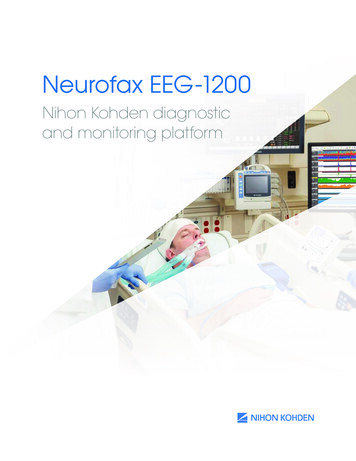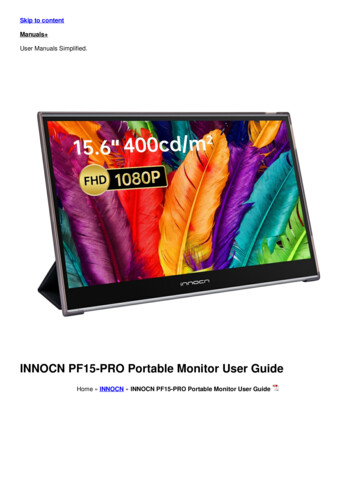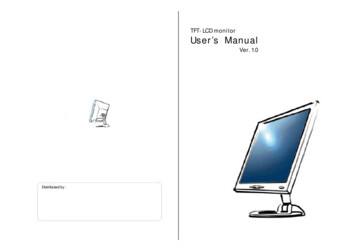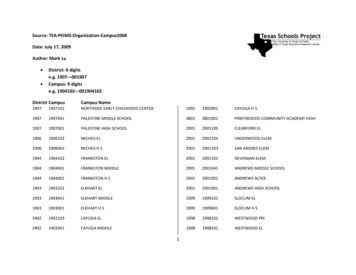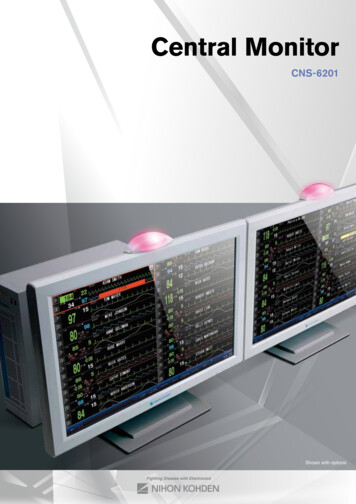
Transcription
Central MonitorCNS-6201Shown with options
Superior central information systemfor your monitoring sceneThe patient monitor of today collects vital signs and notifies the doctor and nurse with an alarm ifit detects an abnormality.What functions do we need for the patient monitor of the future?The patient monitor of the future will give advance warning of potential change in the patient'scondition based on not only the vital signs but also on the latest clinical studies and the clinicalhistory of both the patient and the patient’s family.Nihon Kohden's solution for central information center—it ensures you to keep effective andeasy access to your patient.1
Dual wide displayOne main unit can have two displays that operate separately anddisplay different information. You can view all patient informationon a combination of two display monitors.Up to 32 patientsUp to 32 patients can be simultaneously monitored.Reliable alarmsYou can reduce false alarms by reviewing alarm andmeasurement conditions on the alarm review screen.Flexible 120-hour data storageThe 9 different review screens are time synchronized with eachother so you can review the same patient event in different ways.2
Up to 32 patientsThe CNS-6201 central monitor provides up to 32 patients simultaneous monitoring. You can connect anyLife scope series bedside monitors by Ethernet LAN. You can also monitor telemetry patients’ transmittersignals with a multi patient receiver to create the ideal hardwired, telemetry, or mixed system for yourfacility.Flexible screenlayoutsfor any numberof patients332 patients (dual display)16 patients12 patients10 patients8 patients6 patients4 patients
Easy alarm setupAlarm limits of 8 parameters can set on one screen.All beds limits screenThe all beds limits screen helps you set alarms moreefficiently. Alarm limits for up to 8 patients are shown onone screen so you can check and change alarm settingscompared to other patients.Touch screen operationOperating menus are similar to other Life scope series monitors.Most functions can be done in just 3 steps. With an NKD-ELO24LCD display (24-inch color), you can operate the monitor bytouch screen. You can also use a local purchase display andoperate the monitor by keyboard and mouse.4
Reliable alarmsTypical central monitors cause too many false alarms so staff can’t rely on them.Many false alarms are caused by technical alarms and unsuitable alarm settings.In order to improve this, a new All Beds Alarm Events windowwas added to CNS-6201. This can help reduce false alarmsand provide high quality patient care.Alarm type hide and displayIn the All Beds Alarm Events window, you can hide or display specific alarm types. Vital Alarm EventVital signs alarms indicate thecondition of each parameter. Arrhythmia Alarm EventRed (Bad):more than 10 alarms in one hourYellow (Not Bad):5 to 10 alarms in one hourGreen (Good):less than 5 alarms in one hourYou can check the frequency ofarrhythmias on one screen.This can show the effect of arrhythmiadrugs. Technical Alarm EventThis can help manage the electrodereplacement cycle.*Number of alarms can be changed by setting window.Technical status signalYou can display the frequency of technical alarms in the last hour, indicated by specified color. This shows ata glance the measuring conditions such as electrode attachment or noise.5
Optional alarm indicatorThe alarm indicator on the top ofthe display can be clearly seen ata distance. The blinking or steadylighting condition and color showsalarm information. The blinking alarmindicator can also be synchronizedwith heart rate, blood pressure orSpO2 of a selected patient.Color coded alarm levelAlarms are indicated by a blinking frame and highlighted message.Red shows CRISIS alarms and orange shows WARNING alarmsand yellow shows ADVISORY alarms (highlighted message only).6
Flexible 120-hour data storageSynchronized review dataAll 9 review screens are time-synchronized so that when you find an alarmor arrhythmia episode, you can see the same event on other review screensas full disclosure, trend or numeric data to check details.9 ways1) Trend graphsTrend graphs of 4 parametersand 2 events of the last 120hours can be displayed.2) Tabular trendsNumeric data of measuredparameters for the last 120hours can be displayed in atable.9) Alarm events window120-hour alarm lists for 8persons can be displayedat the same time. There are3 types of alarm displays:vital sign alarms, arrhythmiaalarms, and technical alarms.Time S yn3) Hemodynamics dataUp to 256 hemodynamicsmeasurements can bedisplayed in 8 rows perscreen.4) Arrhythmia recallUp to 1,500 eight-second arrhythmiaepisodes for each patient can bestored and reviewed.7
to review8) Event listUp to 10,000 files within 120 hourscan be saved for each bed. Theevent list window displays the filelist with report creation time, alarmlevels, parameters, descriptions, andother information.7) 12-lead ECG analysischronize d12-lead ECG analysiswaveform, averagewaveform, comparisonwaveforms, and analysisreports from the bedsidemonitor can be displayed.6) Full disclosureSixteen 120-hour full disclosurewaveforms for each patient canbe stored and reviewed.5) ST recallST recall files are created at specifiedintervals. Up to 120-hour files can be saved.7 files can be displayed at the same time.8
Flexible configurationAn optional multiple patient receiver unit receives signals from up to 8 patients’transmitters per ife Scope NetworkNetKonnectWith optional NetKonnect, you can review real-time patient data anytime andanywhere from your PC with a web browser.HL7 GatewayAn HL7 gateway connects the LS-NET monitor network to the HIS (HospitalInformation System). With the HL7 gateway, vital sign data in the bedsidemonitor can be transferred using HL7 protocol.Hospital Network(HIS/CIS)ORHL7 GatewayDoctor’s officeICUCCUNetKonnectServerNICUFirewallGeneral wardInternetGeneral wardWeb browserTransmitters9
CompositionFor a full list of options and consumables, see the technical data separately available.Main unitLCD displayRecorder unitReceiver unitPU-621RNKD-ELO24WS-960PORG-9100Alarm indicator, 2.5 mWS-960P power unit16 patient softwareYL-611PSC-611RQP-625PAlarm indicator, 5 m24 patient softwareYL-612PQP-626P32 patient softwareQP-627P10
This brochure may be revised or replaced by Nihon Kohden at any time without notice.8090 CAT.No.60-014C ’14.12. CLB. C.Printed in Japan
Nihon Kohden's solution for central information center—it ensures you to keep effective and easy access to your patient. 1. uperior central information system for your monitoring scene . 12-lead ECG analysis 12-lead ECG analysis waveform, average . 16 patient software QP-625P 24 patient software QP-626P 32 patient software QP-627P .

